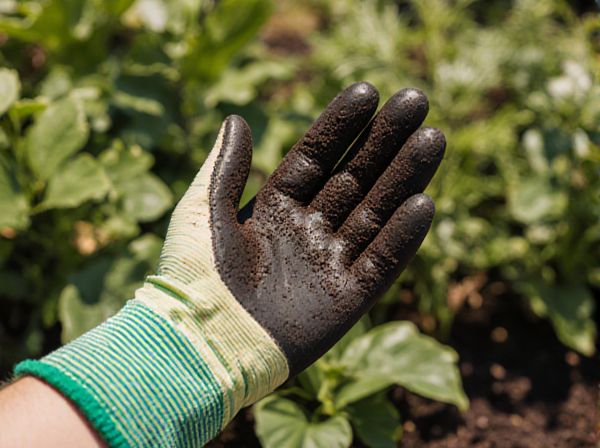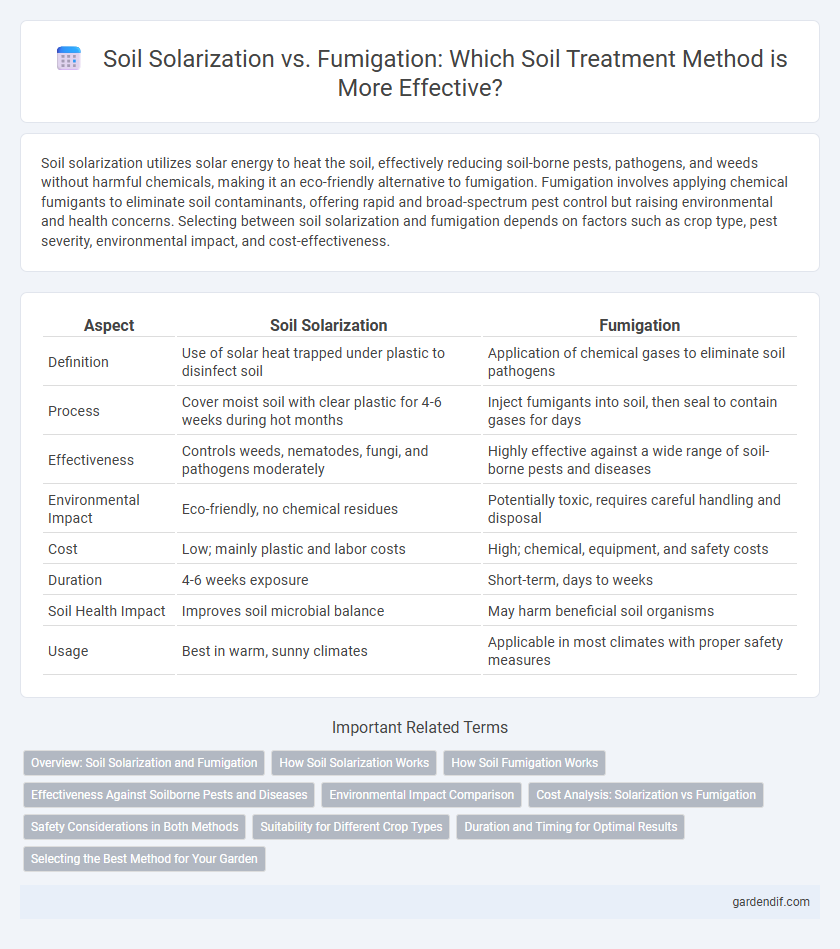
Soil Solarization vs Fumigation Illustration
Soil solarization utilizes solar energy to heat the soil, effectively reducing soil-borne pests, pathogens, and weeds without harmful chemicals, making it an eco-friendly alternative to fumigation. Fumigation involves applying chemical fumigants to eliminate soil contaminants, offering rapid and broad-spectrum pest control but raising environmental and health concerns. Selecting between soil solarization and fumigation depends on factors such as crop type, pest severity, environmental impact, and cost-effectiveness.
Table of Comparison
| Aspect | Soil Solarization | Fumigation |
|---|---|---|
| Definition | Use of solar heat trapped under plastic to disinfect soil | Application of chemical gases to eliminate soil pathogens |
| Process | Cover moist soil with clear plastic for 4-6 weeks during hot months | Inject fumigants into soil, then seal to contain gases for days |
| Effectiveness | Controls weeds, nematodes, fungi, and pathogens moderately | Highly effective against a wide range of soil-borne pests and diseases |
| Environmental Impact | Eco-friendly, no chemical residues | Potentially toxic, requires careful handling and disposal |
| Cost | Low; mainly plastic and labor costs | High; chemical, equipment, and safety costs |
| Duration | 4-6 weeks exposure | Short-term, days to weeks |
| Soil Health Impact | Improves soil microbial balance | May harm beneficial soil organisms |
| Usage | Best in warm, sunny climates | Applicable in most climates with proper safety measures |
Overview: Soil Solarization and Fumigation
Soil solarization uses solar energy to raise soil temperature, effectively controlling soil-borne pests, pathogens, and weed seeds through prolonged exposure to high heat under transparent plastic sheets. In contrast, soil fumigation involves applying chemical fumigants like methyl bromide or chloropicrin to disinfect the soil by releasing toxic gases that penetrate the soil profile, targeting a wide range of soil-borne organisms. Both methods aim to improve soil health and crop yield, but solarization offers an eco-friendly alternative to the often toxic and regulated fumigation chemicals.
How Soil Solarization Works
Soil solarization uses solar energy to heat the soil by covering it with transparent plastic sheets, trapping the sun's heat and raising the soil temperature to levels that kill pathogens, weed seeds, and pests. This method relies on the greenhouse effect to achieve temperatures between 45degC to 60degC for several weeks, effectively sterilizing the upper soil layers without the need for chemical fumigants. Solarization enhances soil health by preserving beneficial microorganisms while reducing harmful soil-borne diseases and improving crop yields.
How Soil Fumigation Works
Soil fumigation works by introducing gaseous pesticides into the soil, effectively penetrating the soil matrix to eliminate pests, pathogens, and weed seeds at a molecular level. This method relies on the diffusion of fumigants like methyl bromide or chloropicrin, which disrupt the biological functions of harmful organisms, resulting in sterilized soil conditions favorable for crop growth. Unlike soil solarization, fumigation provides a rapid and controlled pest eradication process, especially useful for high-value crops and large-scale agricultural operations.
Effectiveness Against Soilborne Pests and Diseases
Soil solarization uses clear plastic sheets to trap solar energy, raising soil temperatures to levels that effectively reduce populations of soilborne pests and pathogens such as nematodes, fungi, and bacteria. Fumigation employs chemical agents like methyl bromide or chloropicrin to penetrate the soil, providing rapid and broad-spectrum control of soilborne pests, including weeds, nematodes, and fungal pathogens. While soil solarization offers an eco-friendly and residue-free alternative with moderate pest control efficacy, fumigation delivers more immediate and intensive suppression but poses environmental and health risks.
Environmental Impact Comparison
Soil solarization uses solar energy to raise soil temperatures and eliminates pests without harmful chemicals, resulting in reduced environmental pollution and enhanced soil microbial activity. Fumigation involves applying chemical fumigants like methyl bromide, which can lead to toxic residues, groundwater contamination, and ozone layer depletion. Compared to fumigation, soil solarization offers a sustainable alternative with lower ecological risks and promotes long-term soil health.
Cost Analysis: Solarization vs Fumigation
Soil solarization typically incurs lower costs compared to fumigation, relying mainly on clear plastic sheets and solar energy rather than expensive chemical fumigants and specialized application equipment. While fumigation offers rapid pest and pathogen control, the higher expenses linked to chemicals, labor, safety measures, and regulatory compliance can significantly increase overall costs. Solarization presents a cost-effective, environmentally friendly alternative for soil disinfestation, particularly suitable for regions with high solar radiation and lower pest pressures.
Safety Considerations in Both Methods
Soil solarization offers a safer alternative to chemical fumigation by using solar heat to reduce soil-borne pathogens without toxic residues or harmful emissions. Fumigation involves volatile chemicals like methyl bromide that pose significant health risks to applicators and nearby communities due to inhalation exposure and environmental contamination. Proper safety protocols, such as protective equipment and restricted access zones, are essential in fumigation, whereas soil solarization primarily requires monitoring soil temperature and coverage integrity to ensure effective and safe treatment.
Suitability for Different Crop Types
Soil solarization is highly suitable for vegetable crops, fruits, and organic farming systems due to its eco-friendly nature and ability to control soil-borne pathogens without chemicals. Fumigation is preferable for high-value crops like strawberries, tomatoes, and ornamentals that require rapid and thorough pest eradication, despite its higher environmental and cost implications. Crop selection depends on factors such as soil type, pest pressure, and production scale, where solarization favors warm climates and fumigation suits intensive agriculture.
Duration and Timing for Optimal Results
Soil solarization typically requires 4 to 6 weeks of exposure to intense sunlight during the hottest months, maximizing the thermal effects to eradicate soil-borne pests and pathogens effectively. In contrast, fumigation duration varies from a few days to a few weeks depending on the chemical used, with optimal timing focused on soil moisture and temperature to ensure deep penetration and pest control. Aligning treatment periods with crop planting schedules ensures minimal disruption while enhancing pest suppression and soil health.
Selecting the Best Method for Your Garden
Soil solarization uses solar energy to raise soil temperature and eliminate pathogens, making it an eco-friendly method ideal for warm, sunny climates. Fumigation employs chemical fumigants to eradicate pests and diseases quickly but requires careful handling and regulatory compliance due to potential toxicity. Selecting the best method depends on factors like garden size, climate, pest severity, and environmental impact, with solarization preferred for sustainable practices and fumigation for rapid, targeted control.
Soil Solarization vs Fumigation Infographic

 gardendif.com
gardendif.com